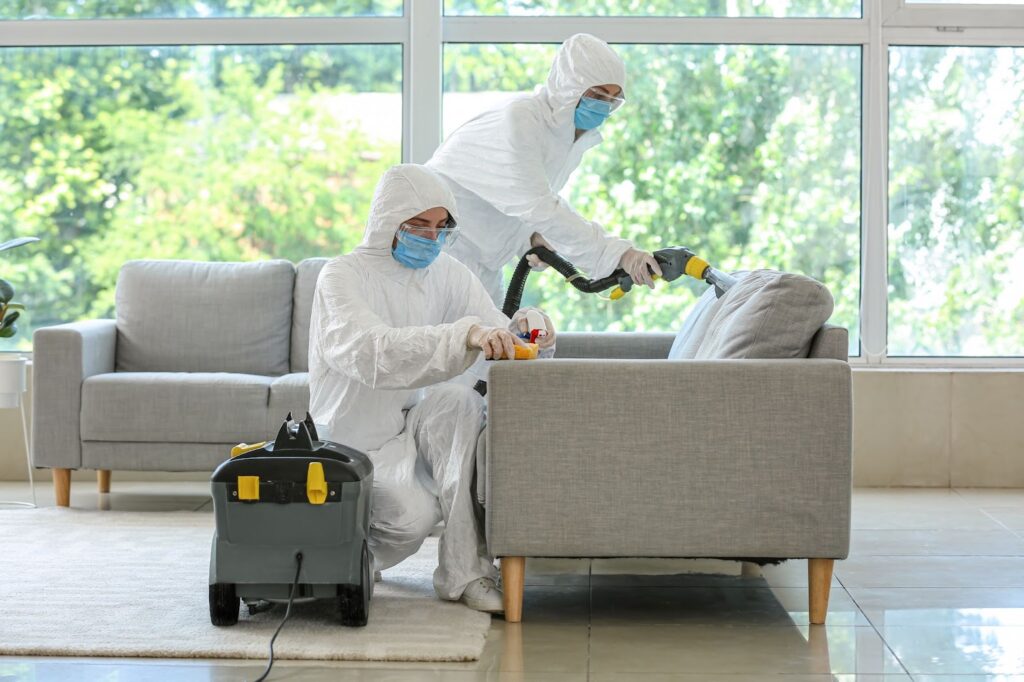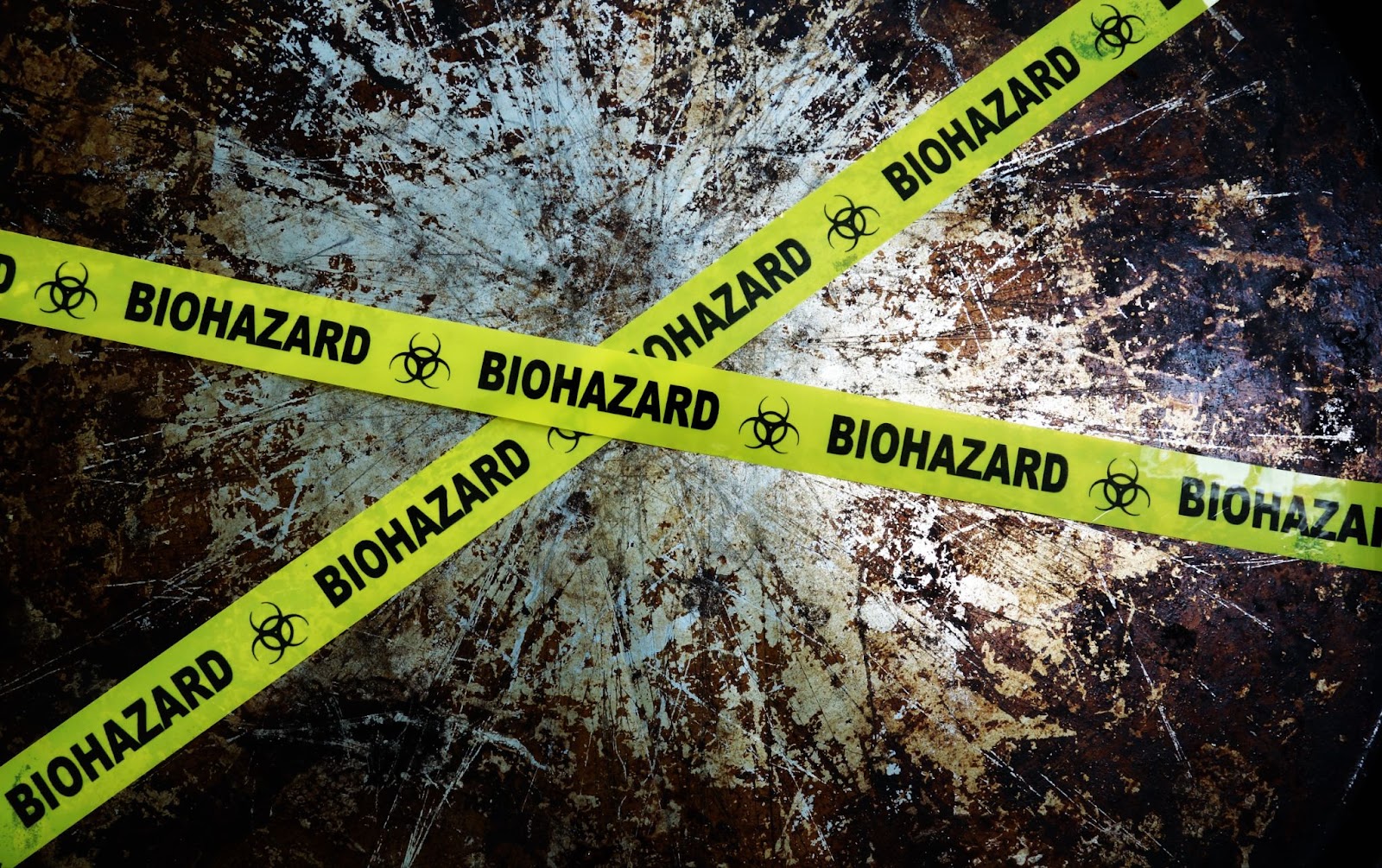When it comes to dealing with hazardous materials, understanding the differences between biohazard cleaning and hazmat cleaning is crucial. Both types of cleaning involve handling dangerous substances, but the nature of these substances and the protocols required to manage them safely vary.
Whether you’re a business owner, property manager, or homeowner, knowing when to call in the right kind of professional help could make all the difference in ensuring safety and compliance with regulations.
Biohazard cleaning and hazmat cleaning may sound similar, but they serve distinct purposes. Hazmat cleaning generally involves the removal of hazardous materials like chemicals, toxins, or radioactive substances, often in industrial or environmental settings.
On the other hand, biohazard cleaning specifically deals with biological materials that pose a health risk, such as blood, bodily fluids, or infectious diseases, which are commonly encountered in residential or commercial spaces.
In this blog, we’ll explore the key differences between these two essential services, with a special focus on biohazard cleanup. By understanding what each service entails and when to use them, you’ll be better prepared to handle situations that require professional intervention.
We’ll discuss why professional biohazard cleanup is vital for safety and legal compliance and how to choose the right service for your needs.
What is hazmat cleaning?
Hazmat cleaning, short for hazardous materials cleaning, is a specialized service focused on the safe removal and disposal of dangerous substances that pose a risk to human health and the environment. These hazardous materials could include a wide range of substances such as toxic chemicals, industrial waste, asbestos, lead, radioactive materials, and various other pollutants.
The goal of hazmat cleaning is to mitigate the dangers associated with these materials, ensuring that the affected area is thoroughly decontaminated and safe for people to re-enter.
The process of hazmat cleaning requires highly trained professionals equipped with specialized protective gear and equipment. This is because the substances involved are sometimes incredibly harmful if not handled correctly.
These experts follow strict protocols and guidelines, often set by regulatory bodies like OSHA (Occupational Safety and Health Administration) or the EPA (Environmental Protection Agency), to ensure that the cleanup is conducted safely and effectively.
The cleanup process typically involves containment, removal, decontamination, and proper disposal of hazardous materials, with careful attention paid to preventing any cross-contamination or further environmental damage.
Common scenarios requiring hazmat cleaning
- Chemical spills: These involve hazardous substances like acids, solvents, or industrial chemicals that can cause severe health risks and environmental damage if not properly contained and cleaned.
- Asbestos removal: Often found in older buildings, asbestos is a dangerous material that requires careful handling and specialized removal to prevent airborne exposure.
- Lead paint abatement: Lead is a toxic metal that can be found in old paint; removing it safely is crucial to avoid serious health problems, especially in children.
- Radioactive material contamination: Situations involving radioactive substances require expert handling to protect against radiation exposure and contamination.
- Industrial accidents: Accidents in factories or other industrial settings might release toxic substances that need immediate and professional cleanup to ensure safety.
What is biohazard cleaning?

Biohazard cleaning involves the removal, cleaning, and disinfection of harmful biological substances that can pose serious health risks to humans. These substances include blood, bodily fluids, human tissue, animal waste, and other potentially infectious materials. Biohazard cleanup is crucial in situations where contamination from these substances could lead to the spread of disease or infection.
This type of cleaning is necessary for a variety of scenarios, including crime scenes, traumatic accidents, and sites of unattended deaths. It is also used in environments where there has been an outbreak of infectious diseases, such as hospitals or nursing homes. Because biohazard materials can be dangerous, specialized training and protective equipment are required to handle them safely.
The process of biohazard cleaning goes beyond simple cleaning; it involves the complete decontamination of the affected area. Professionals use specialized techniques and products to ensure that all traces of biohazardous material are removed and that the area is thoroughly disinfected.
This helps to prevent the spread of pathogens and ensures that the environment is safe for inhabitants or workers to return to.
Common scenarios requiring biohazard cleaning
- Crime scenes: Biohazard cleanup is essential at crime scenes, especially those involving blood or other bodily fluids, to prevent the spread of infectious diseases.
- Traumatic accidents: Accidents that result in significant bodily injury often require biohazard cleaning to safely remove and disinfect blood and other fluids.
- Hoarding situations: Severe hoarding cases might involve the accumulation of biohazardous materials like human waste, animal waste, and decaying food, necessitating professional cleanup.
- Disease outbreaks: Locations that have been exposed to infectious diseases, such as hospitals or residential homes, require biohazard cleaning to thoroughly disinfect and reduce the risk of transmission.
Why professional biohazard cleanup is essential
Professional biohazard cleanup is essential for several reasons, primarily related to health, safety, and legal compliance. Biohazardous materials, including blood, bodily fluids, and other potentially infectious substances, pose significant risks if not handled and disposed of properly.
Professionals are trained to manage these hazards safely, using specialized equipment and following strict protocols to ensure that all contaminants are thoroughly cleaned and the area is safe for occupancy.
One of the most critical aspects of professional biohazard cleanup is the prevention of disease transmission. Bloodborne pathogens, bacteria, and viruses could survive in bodily fluids and on surfaces, potentially leading to the spread of infections if not properly sanitized.
Professional cleanup teams are equipped with the knowledge and tools to eliminate these dangers, protecting both current and future occupants of the affected area.
In addition to health and safety concerns, legal regulations often require professional handling of biohazardous materials. Improper disposal of biohazards could possibly result in severe fines and legal consequences.
Professional biohazard cleanup services ensure compliance with local, state, and federal regulations, giving property owners peace of mind that the cleanup is being conducted according to the law. By hiring professionals, you are not only safeguarding health and safety but also avoiding potential legal liabilities.
Choosing a biohazard cleanup company
Choosing a biohazard cleanup company is a crucial decision that requires careful consideration of several factors. First and foremost, it’s important to select a company that is fully certified and experienced in handling biohazard situations.
Certification ensures that the company follows industry standards and regulations for safe and effective cleanup, reducing the risk of contamination and ensuring the safety of everyone involved.
Experience is another key factor when choosing a biohazard cleanup company. Companies with extensive experience in handling various types of biohazards are more likely to have encountered a wide range of scenarios and will be able to handle the complexities of each situation with expertise.
This experience also means they are better equipped to handle unexpected challenges that may arise during the cleanup process. Consider the company’s reputation and customer service. A reputable biohazard cleanup service should have positive reviews and testimonials from previous clients, indicating their reliability and quality of work.
Additionally, a company that provides excellent customer service is more likely to be responsive, compassionate, and supportive during a very stressful time. Ensure that the service you choose is available 24/7, as biohazard situations often require immediate attention to prevent further contamination and damage.
Trust Utah Disaster Clean Up and Restoration for safe cleanup
When it comes to ensuring a safe and thorough cleanup of biohazard situations, you need a trusted partner who understands the complexities and risks involved. Utah Disaster Clean Up and Restoration is that partner.
Our team is trained and certified to handle the most challenging biohazard cleanup scenarios with precision and care, adhering to the highest industry standards to ensure that your property is restored safely and effectively. We know that dealing with biohazard situations is overwhelming, and we are committed to providing professional service to help you navigate these difficult circumstances.
At Utah Disaster Clean Up and Restoration, we prioritize your safety and peace of mind. We use state-of-the-art equipment and proven techniques to eliminate all traces of biohazards, reducing the risk of contamination and ensuring that your environment is clean, safe, and habitable once again.
Our 24/7 availability means that we are always ready to respond quickly to your needs, minimizing downtime and helping you return to normalcy as soon as possible. Contact us, and let’s get started right away!



